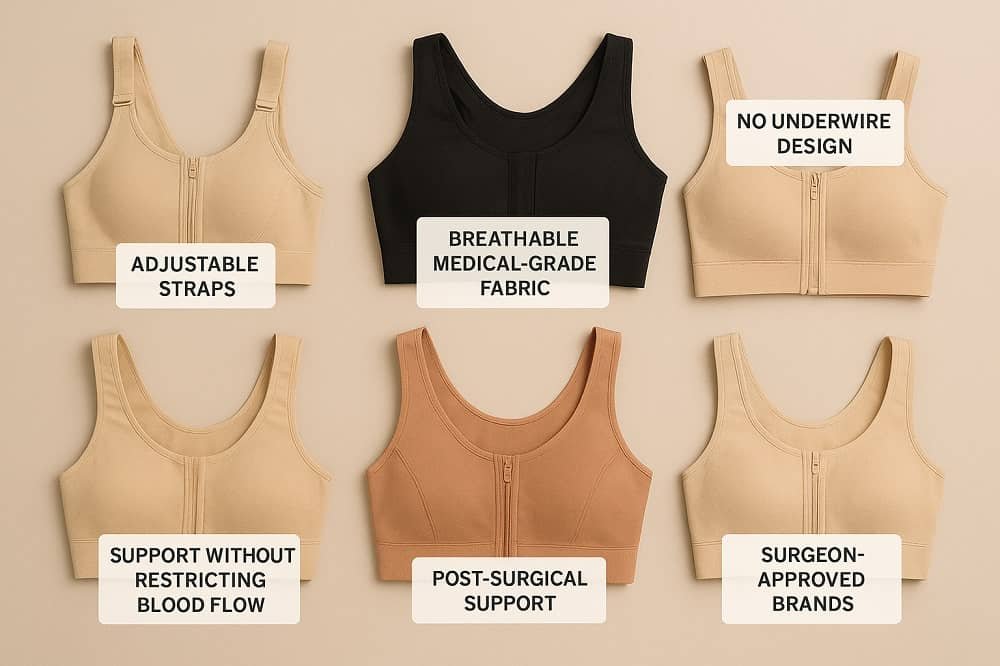Why the Right Post-Surgical Bra Matters
Undergoing breast augmentation surgery is an exciting decision — one that enhances confidence and body image. But the post-surgery journey is equally important. During recovery, every choice you make, especially when it comes to wearing the best compression bra after breast augmentation surgery, impacts healing, comfort, and long-term results.
A properly designed post-surgical compression bra doesn’t just support the breasts — it helps stabilize implants, reduces swelling, and speeds up tissue recovery. It’s more than an accessory; it’s an essential medical garment designed to help you heal better and feel more comfortable every step of the way.
Must Read: Understanding 800cc Breast Implants
What Is a Compression Bra and Why It’s Essential Post Surgery
A compression bra is a specially engineered post-surgical garment made to support the chest and enhance circulation following procedures like breast augmentation, breast lift, or reduction. Unlike regular bras, these provide controlled pressure without restricting movement or blood flow.
How It Differs from Normal Bras
- Medical-grade fabrics: Designed for sensitive skin and healing incisions.
- Front closures: Allow easy dressing after surgery without lifting arms.
- Even compression: Minimizes swelling and fluid retention.
- No underwires: Prevent irritation or pressure on surgical sites.
Medical Benefits
- Reduces post-operative swelling and bruising.
- Keeps implants securely in position during the healing process.
- Enhances lymphatic drainage to avoid fluid buildup.
- Provides comfort and stability, reducing the risk of complications.
Surgeons universally agree that the best compression bra post surgery is one that balances firmness with breathability, offering support while allowing your body to heal naturally.
Key Features to Look For in the Best Compression Bra After Breast Augmentation Surgery

Not all bras are created equal. The right one can make your recovery smoother and safer. Here’s what experts recommend looking for:
Adjustable Straps & Front Closure
These allow easy wear and adjustments without straining your arms — a key factor right after surgery.
Breathable, Medical-Grade Fabric
Choose soft, antimicrobial materials that wick away moisture and prevent irritation.
No Underwire Design
Underwires can press against incision sites and hinder healing. Go for seamless, wire-free designs that offer gentle compression.
Support Without Restricting Blood Flow
A compression bra should feel snug, not tight. Excessive pressure can slow circulation and delay recovery.
Surgeon-Approved Brands
Trusted names like Marena, Lipoelastic, and Macom are often recommended by board-certified plastic surgeons for their medical-grade construction and durability.
Top 7 Best Compression Bras After Breast Augmentation Surgery (2025 List)
Here’s a curated list of surgeon-recommended post-surgical bras, based on comfort, effectiveness, and real user feedback.
- Marena Recovery Bra
Why it’s great: Known for its high-quality medical compression fabric, the Marena Recovery Bra offers consistent support with soft seams and adjustable straps.
Comfort rating: ★★★★★
Ideal for: The first 6 weeks post-surgery.
- Carefix Mary Bra
Why it’s great: Designed with an easy front zipper, the Carefix Mary provides secure compression and a cotton-based lining that’s gentle on healing incisions.
Comfort rating: ★★★★☆
Ideal for: Patients needing moderate compression with maximum breathability.
- BRABIC Post-Surgical Support Bra
Why it’s great: Affordable yet effective, BRABIC’s post-op bra comes with a front closure and cross-back support to prevent implant displacement.
Comfort rating: ★★★★☆
Ideal for: Everyday recovery and sleeping comfort.
- Annette Women’s Post-Surgical Bra
Why it’s great: Designed with high sides and wide straps for enhanced coverage, Annette’s bra is both stylish and functional.
Comfort rating: ★★★★★
Ideal for: Patients looking for all-day wear with extra lift.
- Macom Ultimate Bra
Why it’s great: A premium option recommended by surgeons, Macom uses medical-grade elastane for targeted compression and quick recovery.
Comfort rating: ★★★★★
Ideal for: Women seeking superior post-op shaping and support.
- LIPOELASTIC PI Special
Why it’s great: Manufactured in the EU, this bra offers precise compression levels and is often prescribed by cosmetic clinics for its clinical-grade results.
Comfort rating: ★★★★★
Ideal for: Patients requiring firm control and posture support.
- Burvogue Front Closure Bra
Why it’s great: A stylish, budget-friendly option that transitions well into daily use post-recovery.
Comfort rating: ★★★★☆
Ideal for: Later recovery stages when swelling has reduced.
Expert Tips on Wearing a Post-Surgery Bra Correctly
Even the best compression bra won’t work effectively unless worn properly. Here’s how to get it right:
- Start wearing it immediately after surgery (as advised by your surgeon).
- Wear 24/7 for the first 4–6 weeks, removing only for showering or cleaning.
- Avoid pulling over the head; always use front-closure designs.
- Wash bras gently with mild detergent to preserve elasticity.
- Check the fit — it should feel snug but not overly tight.
Common Mistakes to Avoid
- Choosing fashion bras too soon.
- Wearing underwire bras before your surgeon approves.
- Ignoring discomfort or skin irritation.
Signs It Fits Perfectly
- Even compression without pain.
- Breasts feel supported but not squashed.
- You can breathe and move comfortably.
Difference Between Bras for Breast Augmentation vs. Breast Reduction
Both surgeries require post-surgical support — but the needs differ slightly.
- Focus on stabilizing implants and minimizing upper pole swelling.
- Medium compression works best for positioning.
For Breast Reduction
- Focus on reducing tissue swelling and reshaping natural breast tissue.
- Higher compression levels may be used initially.
Surgeons recommend specialized bras for post breast reduction surgery that provide reinforced lower band support. Meanwhile, bras to wear after breast augmentation focus more on gentle stabilization without excessive compression.
What Surgeons Recommend: Insights from Recovery Experts
Board-certified plastic surgeons emphasize that investing in a high-quality post-surgical bra is as important as choosing the right surgeon.
“A compression bra helps minimize swelling, maintain implant position, and reduce discomfort — it’s one of the most crucial garments for post-augmentation care,” says Dr. Jennifer Walden, ASPS member surgeon.
Surgeons also recommend replacing your post-op bra after 6–8 weeks as your body changes shape during recovery. Always consult your doctor before switching to a regular or sports bra.
The best post surgical bra for breast augmentation, according to most surgeons, is one that offers consistent compression, adjustable fit, and medical-grade fabric tested for clinical use.
FAQs About Post-Surgical and Compression Bras
- How long should I wear a compression bra after augmentation?
Most surgeons advise wearing it continuously for 4–6 weeks, followed by a transition to a light-support bra for another few weeks.
- Can I sleep in my post-op bra?
Yes. Sleeping in a compression bra helps reduce movement and keeps implants stable while healing.
- When can I switch to a regular bra?
Typically after 6–8 weeks, but always confirm with your surgeon before switching — especially before wearing underwire bras.
- Is a sports bra okay for post-surgery recovery?
Only after your surgeon’s approval. Regular sports bras may lack the medical-grade compression needed for early recovery.
Final Thoughts: Comfort, Confidence, and Recovery
Choosing the best compression bra after breast augmentation surgery isn’t just about comfort — it’s about protecting your investment in yourself. A properly fitted, medical-grade post-surgery bra supports healing, helps implants settle naturally, and ensures long-lasting results.
Always consult your surgeon for personalized guidance and opt for brands with proven clinical use. Remember: the right compression equals faster healing and better confidence.
Disclaimer: This article provides general educational information and should not replace medical advice. Always consult your surgeon for individual recommendations.








